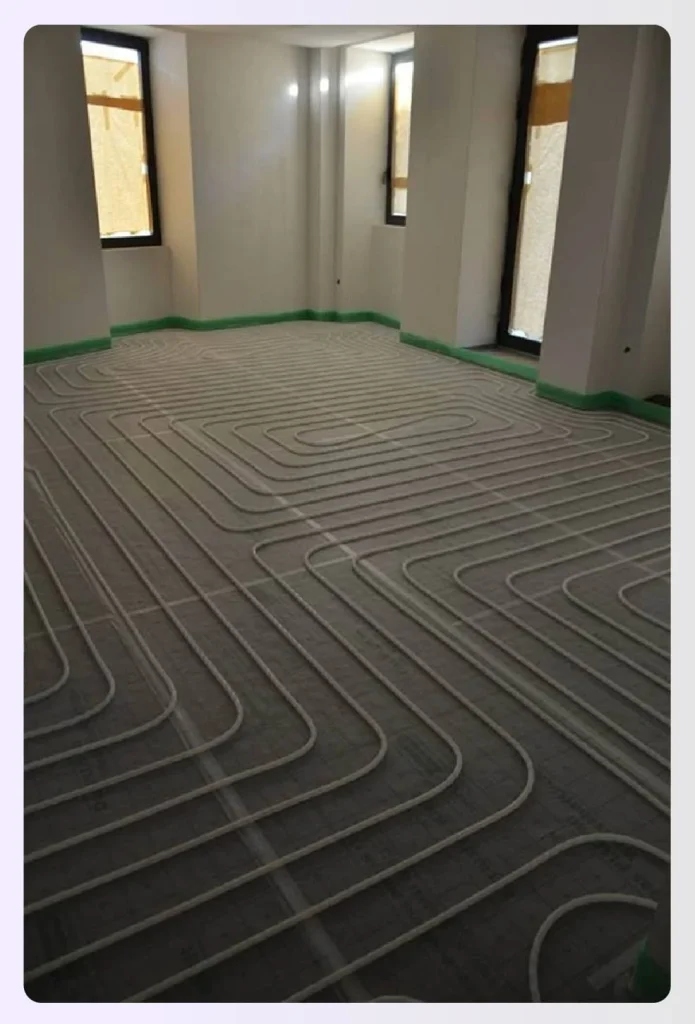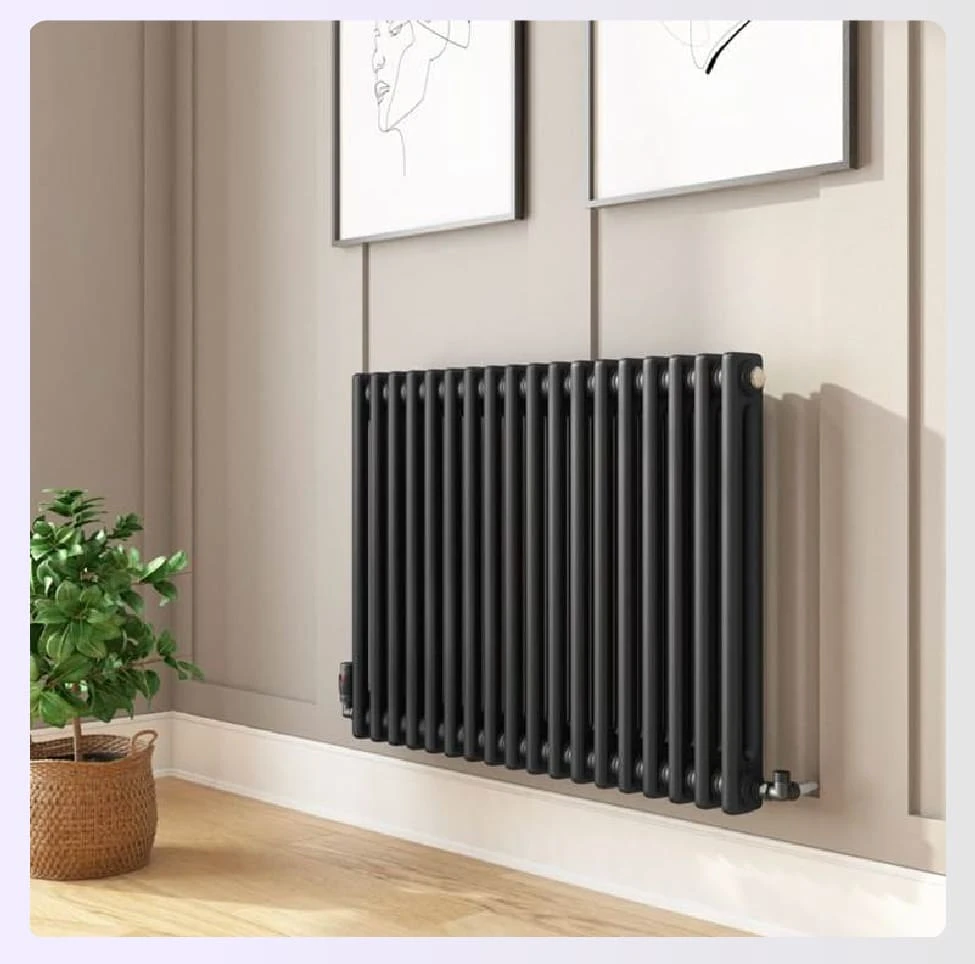Heating systems have been an integral part of most people’s lives, particularly those living in areas with harsh winters. These systems ensure you and your family stay warm and comfortable even if the outside temperatures drop to sub-zero degrees.
If you are someone who has recently moved to such areas and looking to buy a heating system, you must know that there are a variety of heating systems. Furnaces, heat pumps, boilers, radiators, etc., are classic examples. It is critical that you pick the right system that is not only efficient but also cost-effective.
Now, two really popular heating systems available today are underfloor heating systems and radiators. Both have their positives and negatives, making the decision in the underfloor heating vs radiators debate very challenging.
That is where this post can help as we bring you the top differences of underfloor heating vs radiators so that you can make an informed buying decision.
Read also – The Definitive Guide To Space Planning In Interior Design
What is Underfloor Heating?
Underfloor heating (UFH system) is a type of central heating system equipped with an array of heat tubes embedded in the floor. The basic principle of this heating system revolves around the transfer of heat through conduction, convection, and radiation.

Image Credit: Pinterest
There are two types of underfloor heating systems:
1. Hydronic system
This system uses a mix of fluids, mostly water, along with certain antifreeze elements, such as propylene glycol, that act as a heat transfer agent. The hydronic system makes use of a boiler, where the fluid is heated and distributed evenly across the room through the underfloor piping. The boilers, in turn, are powered by fuel sources such as electricity, wood, or biofuels.
2. Electric system
Electric underfloor heating systems use electricity as the primary source of heating. Instead of pipes, these systems employ flexible cables and meshes for transferring heat to the floors and walls. Electric systems have fewer components compared to hydronic systems. The consumption charges for an electric heating system are calculated by the amount of watt power produced by the heating element. But always be careful to take all precautions to prevent any electrical hazards as an interior designer.
Read also – Guide To Use Line in Interior Design
Pros and Cons of Underfloor Heating
Now that you know what underfloor heating is, let us look into the challenges and benefits of underfloor heating systems.
Pros of Underfloor Heating System
- Low maintenance cost: The materials and fluids used in an underfloor heating system are quite sturdy and tough, eliminating the need to perform repeated maintenance activities. In fact, many underfloor heating systems come with a guarantee of at least 25 years with minimal maintenance.
- Energy efficient: Most underfloor heating systems have been built to lower the energy usage. They are considered extremely efficient in performance and energy consumption compared to radiators. Water underfloor heating systems are also capable of retaining heat for a longer period, even after the supply is cut off. This brings down heating bills considerably.
- Low running costs: Though underfloor heating systems generally have low running costs, hydronic systems, in particular, are extremely cost-effective. With the primary source of heat being hot water, there is no need to spend hundreds of dollars on gas and fuel.
- Improved comfort: As these systems use effective heat conduction principles, that too straight from the ground, they distribute the heat around the room evenly. This ensures that you feel the warmth at every corner of your house.
- Environment-friendly: Unlike air conditioners, emitting harmful CFC gases into the environment, underfloor heating systems involve no such process. This makes them a great choice for all environment-conscious people.
- Doesn’t occupy space: As underfloor heating systems are installed below the floor, there is no need to worry about making additional space in your home.
Cons of Underfloor Heating System
- Installation cost: Even though the running and maintenance costs are low in underfloor heating systems, the same cannot be said about the installation costs. Due to the advanced technologies involved and the need to install the system below your floor, homeowners need to spend considerable money on these. Also, underfloor heating systems cannot be installed by everyone as it requires special expertise and skills, shooting the costs even higher. You will also need the help of a plumber to install the system.
- Installation time: If you are looking for instant heating solutions, an underfloor heating system is not your best choice. The entire installation process involves multiple complex steps, such as removing the floor tiles, doing pipework, installing the system, and relaying the floor tiles, all of which take considerable time.
- Increase in floor height: This is expected because you are installing something below your floor. After installing the underfloor heating system, expect a considerable reduction in the distance between your floor and ceiling. This can be particularly disadvantageous for those living in houses with low ceilings.
Read also – Traditional Architecture vs Modern Architecture
What are Radiators?
Compared to underfloor heating systems, radiators are more common and have been used for many years. Radiators are basically heat exchangers that transfer heat continuously from one medium to another through the process of convection.
A radiator typically consists of a boiler (source of heat) and a set of pipes for the water to flow. Water from the boiler gets heated up and flows around the pipes, where it is converted into steam. This is then used for heating the surrounding space.

Image Credit: Pinterest
Read also – 10 Best Smart Technologies for Interior Design
Pros and Cons of Radiators for Internal Heating
With that basic introduction about radiators, let us now look at their positives and negatives to decide if a radiator system is the right choice for you in the underfloor heating vs radiators matchup.
Pros of Radiators
- Efficiency: For a conventional form of heating system, radiators are quite efficient. The efficiency of a radiator can be measured by the decrease in the tangible costs associated with it.
- Faster heating: Radiators heat the room much faster than other heating systems, including underfloor heating systems. They provide instant warmth as soon as you switch on the system. Since the convection process takes place at a faster rate, the time taken by a radiator to heat a room is also quicker.
- Zoned heating: Most radiators come with built-in thermostats that enable you to control the heating levels and room temperature in different parts of your house. In other words, you can create multiple heating zones within the same house based on the level of warmth required in different cold spots.
- Enhanced aesthetics: While underfloor heating systems are not visible to the eyes, radiators come in various designs that can add to the aesthetics of your house. Radiators are available in every size and shape, such as horizontal, vertical, sleek, etc., all of which can effectively blend in with your interiors.
- Smartphone-controlled: With rapid developments in technology, most traditional radiators have become ‘smart’ and can be controlled via smartphone apps. All you need is Wi-Fi connectivity in your house to control the heating levels with a few taps.
Read also – Floor Plan Symbols and Abbreviations
Cons of Radiators
- Radiators cause draughts: There are chances that you might feel cold on your feet even with the radiator switched on. This is because of a simple thermodynamic principle: colder air moves down while hotter air flows up. As the warm air rises to the ceiling and gradually cools down, it tends to settle on the floor beneath.
- Disruption in the room layout: Radiators are mostly wall-mounted, impacting design freedom. This requires that no furniture be placed against that wall space.
- Leakage problems: Most homes use a wet radiator with water flowing in and out of the system. This poses a major threat to the building in the form of water leaks at any random spot.
- High maintenance costs: Unlike underfloor heating systems, radiators demand regular maintenance by a professional. The tubes and vanes should be removed and cleaned at regular intervals for better output. This adds to the maintenance costs.
- Safety issues: Due to the working nature of this system, radiators pose a safety threat to your property. Several accidents have occurred due to radiator malfunctioning.
Read also – 19 Floor Plan Mistakes To Avoid
Underfloor Heating vs Radiator Heating
To make the choice clearer, let’s look at a direct comparison of underfloor heating vs radiators across several key features. This head-to-head breakdown can help you prioritize what matters most for your home.
| Feature | Underfloor Heating | Radiators |
| Maintenance | Virtually maintenance-free | Requires regular upkeep (e.g., bleeding) |
| Comfort | High comfort from even, radiant heat | Moderate comfort; convection causes drafts |
| Cost | High upfront cost, low running cost | Low upfront cost, higher running cost |
| Aesthetics & Space | Invisible; frees up all wall space | Visible; occupies wall space, impacts layout |
| Installation | Complex; best for new builds/renovations | Simple; can be installed in existing homes |
Maintenance
When it comes to upkeep, underfloor heating is the clear winner. Because the system is sealed beneath the floor with no moving parts, it is protected from damage and requires virtually no regular maintenance, often coming with decades-long warranties. Radiators, on the other hand, require regular tasks like bleeding to release trapped air, cleaning between fins to maintain efficiency, and checking for leaks, which adds to the long-term cost and effort.
Comfort
For sheer comfort, underfloor heating provides a superior experience. It uses radiant heat to warm the room from the ground up, gently warming all objects and people for a consistent, draft-free environment. Radiators rely on convection, heating the air which then circulates. This process causes hot air to rise and cooler air to sink, often creating uncomfortable drafts and cold spots near the floor, a common issue in the underfloor heating vs radiators debate.
Cost
The cost factor presents a trade-off in the underfloor heating vs radiators comparison. Radiators have a significantly lower initial purchase and installation cost, making them more budget-friendly upfront. However, underfloor heating systems are more energy-efficient, running at lower temperatures to achieve the same level of comfort. This efficiency translates into lower long-term running costs and considerable savings on your energy bills over the system’s lifespan.
Aesthetics & Space
From a design perspective, underfloor heating is unmatched. As the entire system is hidden beneath the floor, it is completely invisible, granting you total freedom with your interior design and furniture placement. Radiators are bulky, wall-mounted units that take up valuable space and can restrict how you arrange your room. The choice between underfloor heating vs radiators often comes down to prioritizing this design freedom versus a more traditional look.
Installation
Radiators are far simpler and quicker to install, especially in existing properties. A plumber can typically fit a new radiator system with minimal disruption to your home. In contrast, installing underfloor heating is a complex and lengthy process, particularly for retrofits. It often requires removing the existing flooring, laying the system, and potentially pouring a new layer of screed, making it best suited for new construction projects or major renovations.
Read also – How To Design A Home?
Can You Choose the Underfloor Heating and Radiator Heating Together?
Yes, of course you can combine them! Using both systems is a popular and practical solution when you are unsure about the underfloor heating vs radiators debate. For instance, you could install underfloor heating downstairs in an open-plan living area for consistent ambient warmth and use fast-acting radiators in upstairs bedrooms or bathrooms for quick heat boosts when needed. This hybrid approach gives you the best of both worlds: the efficiency of underfloor heating and the rapid response of radiators.
Factors to Consider When Choosing the Home Heating Solution
Now that you have a fair idea about underfloor heating vs radiators, including their positives and negatives, it is time to select one for your premises. To help you with the choice, here is a list of factors to consider before picking one:
- Climate: The first thing you must look for in a home heating solution is its purpose. Countries like the UK, USA, France, etc., are known for their extreme and prolonged winters. If you live in such places, you must select a design suited for extreme climates to ensure low maintenance and operating costs.
- Space: If you have a lot of space in your home and do not mind having an additional component installed on the wall, you can go with radiators. On the other hand, if space is a constraint, embrace underfloor heating systems.
- Availability of service centers and technicians: You do not want to buy a heating system that does not have service centers or skilled technicians in your area to repair it. There are still areas where underfloor heating systems are unheard of.
- Cost: When we talk about cost, you must consider purchasing, installation, maintenance, and repair costs. Pick one that is not necessarily cheaper but offers the best value for the money spent.
- Construction status of your house: As pointed out earlier, underfloor heating systems involve removing and relaying floor tiles. If your house is still under construction and tiling hasn’t been done yet, you can go ahead with underfloor heating systems. It will reduce your installation time and costs considerably.
Read also – Wool Duvet vs Down Comforter
Visualize Your Heating Choice in Your Design with Foyr Neo
Deciding between underfloor heating vs radiators also impacts your interior design. With Foyr Neo, you don’t have to guess. Visualize your complete room layout, furniture placement, and overall aesthetic with either heating choice before making a final commitment.
- Easily create 2D floor plans and convert them to stunning 3D models.
- Drag and drop furniture from our vast library to plan around radiators.
- Experiment with flooring materials compatible with underfloor heating systems.
- Generate photorealistic 12K renders in minutes to see your final design.
Our powerful, AI-enabled interior design software makes interior design accessible to everyone. See exactly how your heating choice will affect your space and create the perfect, cozy home you’ve always wanted.
Start your 14-day free trial now.
Frequently Asked Questions (FAQs)
1. Is it cheaper to run underfloor heating or radiators?
Generally, underfloor heating is cheaper to run. Because it operates at lower temperatures and distributes heat more evenly, it’s more energy-efficient than most radiator systems, leading to lower monthly energy bills. While the initial installation cost is higher, the long-term savings on running costs make it a very cost-effective choice.
2. Is floor heating better than radiators?
“Better” depends on your priorities in the underfloor heating vs radiators choice. Underfloor heating provides more comfortable, even heat and is more energy-efficient. Radiators are cheaper to install and heat a room much faster. For new builds and those prioritizing comfort and long-term running costs, the answer to underfloor heating vs radiators is often the former.
3. Can underfloor heating replace radiators?
Absolutely. An appropriately specified and installed underfloor heating system can serve as the sole heat source for a room or an entire house, completely replacing the need for radiators. This is especially true for well-insulated modern homes. Doing so frees up valuable wall space and provides a more consistent and comfortable ambient temperature.
4. Is underfloor heating enough to heat a room?
Yes, in most cases, a properly designed underfloor heating system is more than capable of being the primary heat source for a room. Its efficiency depends on factors like room size, ceiling height, insulation levels, and window quality. For a standard, well-insulated room, it provides ample, comfortable warmth without needing supplementary heating.
5. Why is my underfloor heating so expensive to run?
If your underfloor heating seems expensive, it could be due to several reasons. Poor insulation is a primary culprit, as heat escapes, forcing the system to work harder. Other factors include an incorrectly set thermostat, using the wrong flooring material that blocks heat, or an improperly designed system. An electric system can also be more expensive to run than a hydronic one.








